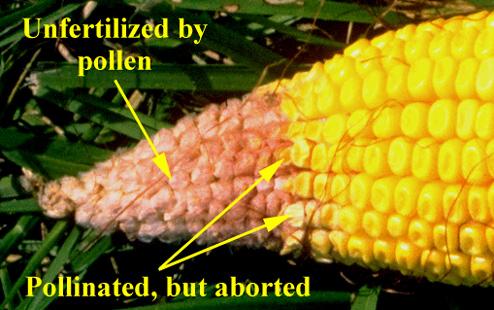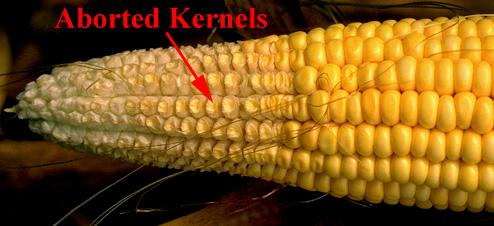Effects of Stress During Grain Fill in CornR.L. (Bob) NielsenAgronomy Department, Purdue University West Lafayette, IN 47907-1150 Internet address: rnielsen@purdue.edu While the pollination period is considered to be the most critical yield-determining interval in the corn plant's life cycle, severe stress on the corn plant during the grain fill period can also result in dramatic yield loss. Yield loss during grain fill can occur from 1) stand loss, 2) incomplete kernel set, 3) lightweight kernels, and 4) premature plant death. Stand Loss During Grain FillYield loss due to stand loss during grain fill is usually greater than that due to stand loss that occurs during the vegetative phase. When stand loss occurs prior to pollination, ear size (number of kernels) on surviving plants may compensate in response to the lesser competition of a thinner stand. Additional compensation may occur during grain fill in terms of greater kernel weight. When stand loss occurs during grain fill, ear size has already been set. Only kernel weight can compensate in response to the lesser competition of a thinner stand. Incomplete Kernel Set in CornKernel set refers to the degree to which kernels have developed up and down the cob. Incomplete kernel set is not always apparent from 'windshield' surveys of a corn field. Husks and cob will continue to lengthen even if kernel set is incomplete. A wonderfully long, robust-looking, healthy green ear shoot can completely mask even a 100 percent failure of pollination or severe kernel abortion. One of the causes of incomplete kernel set is unsuccessful pollination. Unsuccessful pollination results in ovules that are never fertilized and, subsequently, ears with varying degrees and patterns of incomplete kernel set. Many factors can cause incomplete pollination and distinguishing between them can be very difficult.  Certain insects like corn rootworm beetles and Japanese beetles can interfere with pollination and fertilization by their silk clipping action. These insects feed on pollen and subsequently clip silks as they feed on the pollen that has been captured by the silks. Unusually early or late pollinating fields are often particularly attractive to these insects. Drought stress may delay silk emergence until pollen shed is nearly or completely finished. During periods of high temperatures, low relative humidities, and inadequate soil moisture levels, exposed silks may also dessicate and become non-receptive to pollen germination. Unusually favorable conditions prior to pollination that favor ear size determination can result in ears with an unusually high number of potential kernels per row. Remember that silk elongation begins near the butt of the ear and progresses up toward the tip. The tip silks are typically the last to emerge from the husk leaves. If ears are unusually long (many kernels per row), the final silks from the tip of the ear may emerge after all the pollen has been shed. Another cause of incomplete kernel set is abortion of fertilized ovules. Aborted kernels are distinguished from unfertilized ovules in that aborted kernels had actually begun development. Aborted kernels will be shrunken, mostly white, often with the yellow embryo visible; compared to normal plump yellow kernels.  Kernels are most susceptible to abortion during the first 2 weeks following pollination, particularly kernels near the tip of the ear. Tip kernels are generally last to be fertilized, less vigorous than the rest, and are most susceptible to abortion. Once kernels have reached the dough stage of development, further yield losses will occur mainly from reductions in kernel dry weight accumulation. Severe drought stress that continues into the early stages of kernel development (blister and milk stages) can easily abort developing kernels. Severe nutrient deficiencies (especially nitrogen) can also abort kernels if enough of the photosynthetic 'factory' is damaged. Extensive loss of green leaf tissue by certain leaf diseases, such as grey leaf spot, by the time pollination occurs may limit photosynthate production enough to cause kernel abortion. Consecutive days of heavily overcast, cloudy conditions may also reduce photosynthesis enough to cause abortion in recently fertilized ovules. Decreased Kernel WeightSevere stress during dough and dent stages of grain fill decreases grain yield primarily due to decreased kernel weights and is often caused by premature black layer formation in the kernels. Decreased kernel weight can result from severe drought and heat stress during grain fill; extensive European corn borer tunneling (especially in the ear shanks); loss of photosynthetic leaf area by hail, insects, or disease early in grain fill; and killing fall frosts prior to normal black layer development. Once grain has reached physiological maturity, stress will have no further physiological effect on final yield, because final yield is already achieved. Stalk and ear rots, however, can continue to develop after corn has reached physiological maturity and indirectly reduce grain yield. Premature Plant DeathA killing fall frost prior to physiological maturity can cause premature leaf death or whole plant death. Premature death of leaves results in yield losses because the photosynthetic 'factory' output is greatly reduced. The plant may remobilize stored carbohydrates from the leaves or stalk tissue to the developing ears, but yield potential will still be lost. Premature death of whole plants results in greater yield losses than if only leaves are killed. Death of all plant tissue prevents any further remobilization of stored carbohydrates to the developing ear. Whole plant death that occurs before normal black layer formation will cause premature black layer development, resulting in incomplete grain fill and lightweight, chaffy grain. Grain moisture will be greater than 35%, requiring substantial field drydown before harvest. |